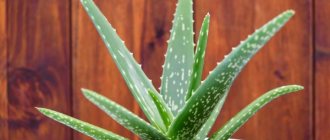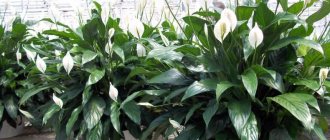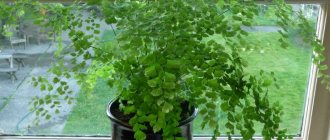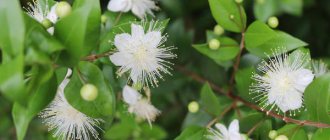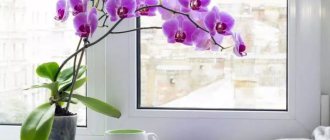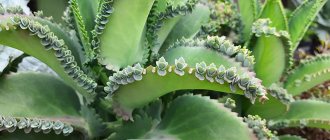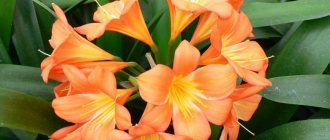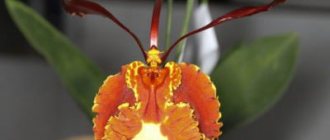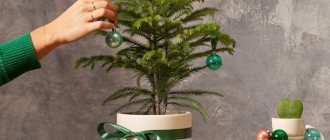- August 16, 2019
- Houseplants
- Ksenia Stepanishcheva
Fern is great for landscaping apartments and houses with insufficient lighting. This plant is considered shade-tolerant, so it can be placed on north-facing windows, in bathrooms, kitchens, and hallways. It also feels comfortable at high temperatures and humidity. How to care for ferns at home is described in the article.
Peculiarities
Ferns grow in different climates, in meadows, swamps, and forests. They can also be on trees, but most of them are found in the tropics. It is tropical species that are suitable for growing at home. There are also species that are frost-resistant. Gardeners willingly grow ferns in their garden plots.
All varieties of plants include 2 parts: roots and openwork, feathery, arched leaves, which are called fronds. Many ferns have pinnately dissected leaves, but there are species with solid leaves that differ in shape and size.
Plant reproduction occurs by spores, like fungi, mosses and algae. They are hardy in nature, but may not survive in the home even with quality care and the creation of suitable conditions. You can determine the cleanliness of the air by plants: if they are in a polluted atmosphere, the leaves wither.
Indoor fern - environmental inspector
Indoor ferns , like their wild relatives, are considered unpretentious plants. But, nevertheless, not in all conditions they will grow well and look attractive. In the forest, ferns thrive on sandy and especially peat soils. Moreover, without daily watering, in the heat, without replanting or pruning. But in an urban environment, even in good soil they can wither away. Why? Because ferns are a kind of indicator of the purity of the atmosphere.
Ferns do not tolerate gas pollution and smoke in the atmosphere very well, they react to dry air, and if you decide to have an indoor Fern at home, then first of all provide it with access to fresh air. But on the other hand, if you bought this flower, and at home it began to wither, this is a reason to wonder if everything is in order in your apartment. Maybe there's a gas leak somewhere or it's time to install a hood in the kitchen. In addition, the indoor fern may dry out due to low air humidity - this is a hint to you that it is time to buy a humidifier or at least place a couple of vessels with water in the house for evaporation.
- Monstera
Manifold
There are several types of indoor ferns that take root well at home:
- Maidenhair. This plant has thin, strong stems and graceful fronds. It prefers warmth, shade and moisture. It is advisable to grow this species in winter gardens and terrariums. Names: Radi, Delicate, Fine-haired, Venus hair.
- Asplenium. This type of indoor fern likes to be in the shade and in moist air. At home, several species are bred that are not similar to each other. These are Nesting and Bulbous, Viviparous.
- Nephrolepis. The plant needs space. The fronds are dissected, which ensures an original openwork effect. Nephrolepis sublime is commonly grown and is very easy to care for. Reproduction is carried out by dividing a large bush or by shoots.
- Blekhnum. The crown is 1 meter in diameter, and the rigid fronds are similar to a palm tree. Commonly grown blechnum humpback and brazilian.
- Davallia. The plant has thick rhizomes. That's why it is called hare's or squirrel's feet.
- Platycerium. The fern has large, showy leaves, like the antlers of a deer.
- Disconia. A mature plant can be 3 meters tall, so it is suitable for spacious rooms.
- Pelley. The plant prefers dry habitats. Pellea Roundifolia and Green are in demand.
- Polypodium. The leaves of the plant are heavily dissected.
Large plants look original in hanging pots and stands. Their feathery leaves are used to decorate bouquets. Torn fronds are quickly restored.
Types of pelleys with photos and names
Pellea rotundifolia
This species differs from the others in that it is easiest to grow indoors, because it is the most unpretentious. There are sometimes serrations on the edges of the pinnate leaf blades. The front surface of the foliage is dark green, and the back surface is lighter.
Pellea green
The roots of this species are creeping, and the edges of the leaf blades and shoots are chocolate-colored. The succulent leaves have a rounded shape. This plant differs from other species in that it is larger and its foliage is oblong in shape.
The stems of this species are creeping, and the shape of its leaf blades is triangular. The foliage reaches approximately 0.6 m in length.
Pellea naked
This plant has a rather spectacular appearance. The stems reach a height of up to 0.35 m. The foliage is formed on bare shoots of a dark brown color. The species needs a lot of light and is highly frost-resistant.
Pellea dark purple
The length of foliage of this type reaches up to half a meter. There is slight pubescence on the surface of the purple shoots. Experts advise that for this plant cultivated indoors, choose a place located next to a north window.
Pellea ovoid
This compact fern is distinguished by its elegance. The large, heart-shaped leaves are pale olive green. The bush can reach a height of about 0.4 m; it grows well in bright, diffused light.
Hanging branch "Pelleus"
Watch this video on YouTube
Features of care
How to care for ferns at home? The plant needs regular watering and maintaining comfortable humidity. Almost all types of ferns are drought intolerant. Optimal temperature and lighting are important. It is necessary to properly transplant and propagate ferns. In the absence of competent maintenance, it dies.
If the plant is located near other house flowers, you should check that its openwork leaves are not squeezed. The fronds are fragile and need free space. Damaged and dry leaves should be removed in a timely manner, ensuring the free development of young shoots.
Watering
The plant loves water. Prolonged drought destroys it. How often should you water your fern? The procedures should be performed after the top of the soil has dried.
But excess moisture also negatively affects the root system and can lead to the death of the plant. If there is too much moisture, yellow and brown spots will appear on the leaves, the roots will rot, and the plant will dry out. Watering should be done several times a week with settled water at room temperature.
Description of culture
As we already know, fern is an ancient plant, unpretentious and capable of filling all the empty spaces in the garden. Great for filling space under trees, near the walls of the house.
Despite the fact that there are a huge number of varieties, they are all similar in characteristics:
- Perennial herbaceous plants.
- The appearance is almost identical, the differences are minor.
- The rhizomes are all medium in size.
- Reproduction occurs both in garden soils and in special pots (indoor species).
Temperature
How to care for a fern at home so that the plant does not die? It is necessary to ensure the optimal temperature. It is 15-22 degrees. But the specific regime is selected based on the type of plant.
Eat:
- Heat-loving. These include nephrolepis, asplenium, platycerium. In winter the temperature should be at least 18 degrees.
- Resistant to low temperatures. This is a polypodium, pimpulate, pellea. Plants can live at temperatures as low as 12 degrees.
Any type of fern does not need drafts, but they thrive in fresh air. The room where the flower is located should be regularly ventilated.
Soil preparation
The soil for indoor ferns should be loose, allowing air and water to pass through. Stagnant moisture causes root rot. It is desirable that the soil contains a lot of rotted leaves and a little less pine needles and peat.
Ferns need soil with slightly increased acidity (pH is 5.0-6.6). The parameter is easily established using litmus paper. Soil (2 g) must be mixed with distilled water (10 ml). Shake the mixture and let it sit for a while. Then you need to lower litmus paper into the liquid above the sediment. At pH = 5 it will be yellow, and at 6 it will be greenish-yellow.
What ready-made soil can be purchased in stores?
Now on store shelves you can find various types of soil for indoor plants. They indicate acidity, ingredients, composition.
Knowing what soil composition is favorable for nephrolepis, you can find a suitable one in specialized stores, with a recommended acidity of 5-6.6 ph.
Vermicompost in various variations and leaf humus are added to purchased soil for succulents (peat, sand, minerals).
But in any case, this soil should not contain:
- stones
- glass
- large pieces of wood
- weed seeds
For young bushes, the soil should be shallower, softer, and more loose. To create this effect, expanded clay, foam chips, and ground pumice are added to the pot in small proportions.
There are several popular methods for preparing and preparing the soil yourself.
Leaf soil is mixed with verticulite, expanded clay, greenhouse and turf soil, and coarse sand in a ratio of 2:1:1:1:1.
Mix humus, peat and leaf soils in equal proportions. Mix peat, humus, and leaf soil in equal proportions and add a little bone meal, about 1/5, to the resulting mixture.
You cannot use heavy clay soils, since nephrolepis will not be able to fully receive nutrients and liquid, it will begin to hurt, and the root system will rot in such an environment.
Fertilizer
Feeding the fern is not necessary, since it feels fine without it. If they become pale and small, this indicates a lack of nutrients in the soil.
The plant needs feeding during the period of active growth - late spring and summer. It is advisable to fertilize using liquid complex mineral compositions, for example a solution, 1 liter of which includes:
- potassium salt – 1 g;
- superphosphate – 1.5 g;
- ammonium nitrate – 1.5 g.
You need to use organic matter with caution, as it can cause burns. Some gardeners periodically add tea leaves to the pot or water with a weakly infused drink.
Features of transplantation
This plant is fast-growing, so it needs to be replanted annually when young. And adult species - every 2-3 years. The procedure is performed in the spring.
How to plant indoor ferns? To avoid harming the plant, you need a large pot. Indoor ferns are transplanted using the transshipment method. During this procedure, you should not dig the base of the rosette of leaves into the ground.
It is not necessary to clear the soil from the roots of the flower to prevent damage to the fragile roots. An exception is a disease of an indoor flower, in which it is necessary to identify damaged roots and remove them.
For replanting, you should purchase a soil substrate with an acidic environment or prepare the soil yourself. To do this you will need:
- land - 1 part;
- humus – 1;
- peat – 1;
- bone meal - ½ part.
Timely replanting ensures normal development of the plant. It must be done carefully and without haste.
When can I plant and how to replant?
For the growing season, you need to fulfill several simple conditions, then the plant will delight you for many years to come:
- When planting, choose a shaded area of the garden.
- The roots need additional air, so loosen the soil well before planting.
- Plant in open ground in spring, as the fronds are actively blooming at this time.
When replanting a fern, immediately provide moist soil and a large amount of water for topping up. But also try not to overwater, as this can lead to illness.
During replanting, also prepare peat. It will serve as fertilizer and leavening agent.
Landing place
The plant should be planted near the house, or in the depths of the garden in a closed place . Please note that the place should be dark and damp.
For beauty, use flowerpots, stumps and other various decorations.
The sun is needed only for one variety of fern - nomadic fern. He needs bright light and warmth to reveal his beauty. Other species are planted in partial shade.
Root system protection
A plant brought from afar needs additional protection of the root system.:
- When transporting, wrap the roots with a damp cloth or moss. Don't disturb the earthen lump.
- Land immediately.
- Periodically loosen the soil to provide oxygen to the roots.
- Regular watering.
- Constant control of soil moisture.
If the soil is initially fertile and rich in mineral fertilizers, then fertilizing as such is not necessary. But you still need to do the following if you want your fern to grow for many years in a row and without diseases - add nitrogen-rich fertilizers to the ground.
Water the soil with “ArganiQ” - this procedure will help the plant to easily adapt to the garden soil.
All pests that accidentally or not accidentally fall on the leaves of your plant must be collected manually. This way the fern will not die.
Lighting
The best lighting for a fern is diffused sunlight , since without any sun the leaves of the plant turn yellow and die. This significantly deteriorates the appearance of herbaceous plants.
Capacity
You need shallow, wide flower pots. Medium ones are fine to start with, but it is important that they are the right size for the root system. In a container that is too large, the plant often gets sick, and in a small container it stops developing.
As they grow, they will need to be transplanted into larger flower pots. It is important that the container is round, without curved edges, since during transplantation it will be easier to transfer the soil tuber.
To grow flowers, experts recommend using clay pots, which allow the roots to “breathe” and do not release components that are toxic to humans. You should not worry about external unaesthetics; the container will be covered with thick foliage. Clay pots are massive and stable, so they can hold a flower. Their disadvantage is that microbes and pathogenic fungi can enter the root system with air.
Reproduction
How to grow fern at home? Plant propagation is carried out using:
- dividing the bush;
- dispute.
The second option is complex and time-consuming. Therefore, even professional flower growers rarely use it. The brown dots on the bottom of the leaf are spores that the plant uses to reproduce.
At home, ferns are propagated by division. For this you need young root rosettes. They should be separated carefully so as not to harm the plant. It is advisable to do the division on a cold, cloudy day.
How to care for a plant that was recently planted? It is imperative to provide suitable air humidity (about 70%) and abundant watering for 2 months. Dry air and soil in a pot can damage the fern.
Landing conditions
It is important to decide on a place for the fern before planting. Gardeners consider shaded areas to be the most suitable. The soil should not be too heavy and well moistened.
Such parameters will create ideal conditions for growth. If you plant a fern in a sunny place, it will not reach the required size and will be weak. A well-chosen place and proper care will allow you to grow a beautiful plant.
Ferns require virtually no fertilizer. It can be safely planted in an area where other flowers do not take root. For giant species, up to 30 cm should be left between holes intended for planting. This distance can be either increased or decreased.
The photo shows a fern planting
When planting, pay attention to whether other plants will interfere with the fern's growth.
If it has extensive roots, then it is better to provide a spacious area, and also put restrictions for root growth, decorated like an ordinary fence.
When the planting site has already been chosen, it is necessary to prepare the soil and the plant itself for planting. Ferns are also planted in the fall; before planting, a pot with rhizomes is placed in the hole.
After the air bubbles disappear, you need to pull out the root and plant it in the ground. The hole is also moistened before planting. Make sure that some of the soil in which the plant previously grew remains on the rhizome. If the plant grew at home, the soil is taken from a flowerpot, if in the forest, then the soil will be forest soil.
By choosing the right soil, you “help” the plant to take root faster. It is better not to touch the foliage so as not to disturb the decorative appearance of the fern.
Having straightened the roots in the hole, you need to cover them with soil and water them with settled water. Plants in pots, planted throughout the year.
Difficulties
If the fern is not cared for properly, it will get sick. The following pests often appear:
- Nematode. Appears when watering with cold water and chlorine. The leaves will be yellow and dry. The only way to save it is to transplant it into a new pot, which is pre-treated with insecticides. But treatment is not always successful; sometimes the fern dies.
- Scale insects, thrips, aphids. They usually start on a fern that is located in a room where the air is too dry. Regular spraying and a warm shower can prevent damage to the flower. If pests still appear, the plant must be treated with insecticides.
Diseases and pests are not all the problems that gardeners face. Plants react sensitively to inappropriate conditions, which is why they become yellowed and dry. Ferns dry out due to:
- low or high temperature (more than 25 degrees);
- using cold water;
- watering with liquid containing a lot of chlorine;
- dry air, presence of heating devices near the flower;
- exposure to direct sunlight;
- growing in a cramped pot or lack of nutrients in the soil.
Therefore, it is important to provide suitable conditions for the plant. Even minor violations can cause these problems.
Diseases and pests, combating them
Ferns are susceptible to diseases, like any other indoor flower. In order to prevent the occurrence of pathogenic bacteria and the invasion of parasites, it is worth following the care conditions and constantly monitoring the condition of the plant.
The following diseases are identified that most often affect ferns:
- Rotting of the root system - initially the problem is reflected in the foliage, it begins to turn yellow, then turns brown. To prevent the formation of a fungal disease, it is necessary to correctly add the amount of nutrient moisture and avoid overmoistening.
- Gray rot - on any section of the bush, as well as on the soil substrate, there is a pile of gray plaque. To save the bush, you need to put it in quarantine, away from other plants from the collection. Remove all damaged parts. If possible, disinfect the soil and spray the branches with anti-mold chemicals.
- Anthracnose - Brown streaks form at the ends of the leaf blades. All diseased leaves should be removed from the plant, and healthy ones should be treated with a fungicide. In this situation, it is recommended to reduce the application of nutrient moisture somewhat, and also remove spraying for a while.
- Spotting on leaf blades - brown spots of a weeping nature form on the foliage. To save your pet, you should completely remove all affected areas, also reduce watering to a minimum and spray with chemicals.

